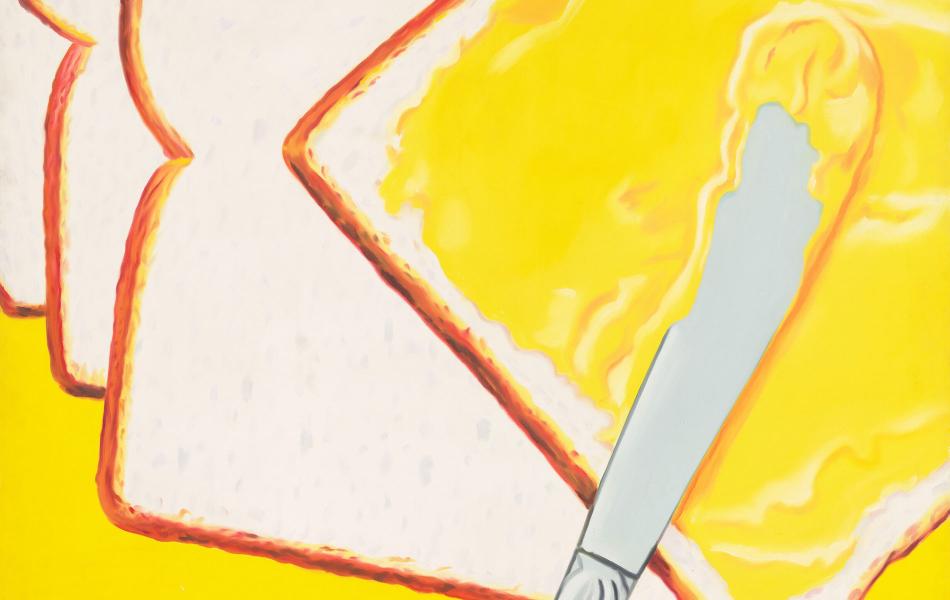White Bread
1964
James Rosenquist
Artist, American, 1933 - 2017

James Rosenquist, a major American painter associated with pop art, was not represented by a painting in the Gallery’s collection prior to the acquisition of White Bread. This work is a significant addition, joining important paintings from the same period by Roy Lichtenstein and Andy Warhol as well as numerous prints and several drawings by Rosenquist from all periods of his career.
After studying art with Cameron Booth at the University of Minnesota, Rosenquist moved to New York City in 1955 on a scholarship to the Art Students League. His breakthrough came in 1960, when he got married, quit his sign-painting job, and found a loft in Coenties Slip in Lower Manhattan, joining a group of young mavericks that included Ellsworth Kelly, Robert Indiana, Agnes Martin, and Jack Youngerman. Here Rosenquist gave up his abstract-expressionist efforts and let his commercial experience invade his art. The results were a series of monumental paintings based on jagged collages of images drawn from magazines on his studio floor and views out his window.
White Bread, 1964, is one of Rosenquist’s best-known works from this period, but it is not typical. The scale is relatively modest and the composition is not interrupted by the sharp divisions and overlaid images that usually emerged from his collage process. Instead, the divisions and overlaps are elegantly found in the subject itself—four slices of store-bought white bread, the top one being buttered with the world’s yellowest spread, probably margarine, courtesy of an ordinary stainless-steel knife.
Rosenquist never fit comfortably into the pop category, as this painting demonstrates. On the one hand, he generally eschewed brand names and logos, preferring to use more generalized commercial images. On the other hand, he dared to approach commercial illustration techniques even more closely than did his cohorts: witness his efficient but careful rendering of the grooves in the knife and the gloss on the spread. At the same time, for all of its loving detail, this work can be considered largely as an abstraction. The canvas is divided into simple shapes and the use of the same yellow for both the spread and the background flattens the space, calling attention to the patterns formed by the bread crusts. The compositions of Ellsworth Kelly are not far away (and, indeed, the artist suggested that Kelly’s initials can be found in the crusts).
This painting is about culture and consumption and American consumerism, but it is also (even more than most still lifes) a painting about painting—about the application of color to a support and its stunning visual results.
Artwork overview
-
Medium
oil on canvas
-
Credit Line
-
Dimensions
overall: 138.43 × 154.31 × 5.72 cm (54 1/2 × 60 3/4 × 2 1/4 in.)
-
Accession Number
2008.36.1
More About this Artwork

Article: Food Art Favorites to Feast Your Eyes On
Feast your eyes on our top 10 favorite food paintings at the National Gallery and download your favorites for free. See still lifes and pop art by Paul Cézanne, James Rosenquist, Robert Seldon Duncanson, and more.
Artwork history & notes
Provenance
(Galerie Ileana Sonnabend, Paris), in 1964; (Gian Enzo Sperone Arte Moderna, Turin), in 1964; Remo Morone, Turin; acquired 1964 by private collection; (sale, Sotheby's, New York, 15 November 2007, no. 888); (Acquavella Galleries, New York); purchased June 2008 by NGA.
Associated Names
Exhibition History
1964
Rosenquist, Galerie Ileana Sonnabend, Paris, 1964, unnumbered catalogue, repro.
Rosenquist, Gian Enzo Sperone Arte Moderna, Turin, 1964, unnumbered catalogue, repro.
1965
Alternative Attuali 2: rassegna internazionale di pittura - scultura - grafica, Castello Spangnolo, L'Aquila, 1965, unnumbered catalogue, repro. on cover.
1967
Biennale Internazionale d'Art Republica San Marino: Nuove Techniche d'Immagine, Palazzo dei Congresse, San Marino, 1967, repro.
1969
New-Dada e Pop Art Newyorkesi, Galleria Civica d'Arte Moderna, Turin, 1969, no. 42, repro.
2004
Das Grosse Fressen Von Pop bis Heute, Kunsthalle Bielefeld, 2004, unnumbered catalogue, repro. 51.
2005
James Rosenquist: A Retrospective, Kunstmuseum Wolfsburg, 2005.
2018
James Rosenquist: This American Life, Acquavella Contemporary Art, Inc., New York, 2018, unnumbered catalogue, repro.
Bibliography
2008
Cooper, Harry. "James Rosenquist, White Bread." National Gallery of Art Bulletin no. 39 (Fall 2008): 27, repro.
Inscriptions
on reverse: [signed, titled, dated]
Wikidata ID
Q20196300

